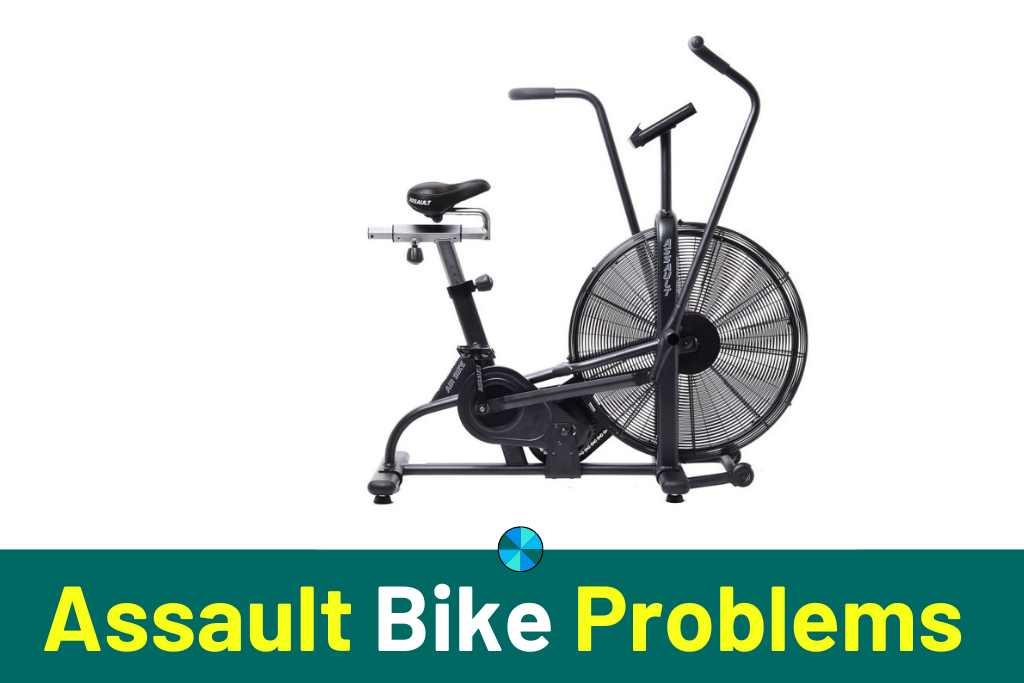No matter what kind of assault bike you possess, there are always a few typical issues that might arise. Additionally, this is not limited to exercise bikes, and you should be aware of frequent problems that might occur with treadmills, ellipticals, and many other types of exercise equipment.
6 common problems with assault bikes are:
- Weird Noises
- Less or No Resistance
- Heart-Rate Readings are Inconsistent
- The Belt is Slipping
- Display Console Issues
- It’s a Heavy Piece of Equipment
Let’s discover more detail about each of these issues and how you can fix them.
6 Common Problems with Assault Bikes
Here are five typical issues with exercise bikes, along with advice on how to fix them:
1. Weird Noises
Many manufacturers could claim that their exercise bike is smooth and quiet to use. Even if this could be the case, you might be somewhat perplexed if you notice that your assault bike starts to produce strange noises.
Determine the source of the noise before you draw any conclusions. In most cases, the wheels, belts, or pedals are the most likely sources of an odd noise. Regardless of what part it is, it probably has to be taken apart and lubricated or tightened and loosened.
Scrutinize the threads to determine whether the issue is primarily with the pedals. Your pedals might need to be replaced if worn out and replaced if they don’t align 90 degrees with the crank arm.
Another possibility is that the threading has broken or crossed across. If so, you should get in touch with a service provider so that the entire pedal arm may be changed.
2. Less or No Resistance
You can experience a problem with your exercise bike when the resistance is applied with little or no variation during your exercises.
Cross-cabling or bent pins are the most frequent causes of resistance problems. A shaky resistance wheel, though, maybe the culprit. The hub has to be changed if this is the case.
If the magnetic resistance system on your exercise bike isn’t working correctly, there might be loose nuts or screws causing the magnets to move from their original position.
Ensure the magnets are correctly fastened in their intended location to resolve the problem.
If the wiring leading to the magnet’s resistance control is flawed, the magnetic resistance may also face problems. Contact a support center in this situation.
3. Heart-Rate Readings are Inconsistent
Any cardio equipment with a heart-rate monitor is beneficial, especially for people who want to improve their cardiovascular health safely.
But as with any technology, components might occasionally fail. Heart-rate monitors are no exception, and you can notice that your monitor gives you pretty inconsistent readings.
Fortunately, fixing this is usually relatively straightforward. Verify that the heart-rate grips and straps are securely fastened to the bike’s frame.
Your readings won’t be as exact as you need them to be if the heart-rate monitors are loose.
Heart-rate monitoring isn’t an exact science, so bear that in mind. When monitoring your heart rate, you should consider the reading the device provides you as a range or a starting point rather than a precise assessment of where you are.
4. The Belt is Slipping
You could begin to notice the drive belt sliding if it is worn out. If you ride your exercise bike regularly, this problem could frequently arise since your activities put the most strain on the drive belt.
You shouldn’t disregard a drive belt sliding sensation since it might cause catastrophic damage. If your drive belt slips, it must be adjusted or replaced immediately.
Ensure the bike is disconnected from the power source or turned off before adjusting the drive belt. After removing the top and bottom shields, remove the two pedals. You’ll have accessibility to the belt and flywheel if you do this.
Tighten the idler bolts and the adjustment nut to tighten the belt. Ensure you have the appropriate replica component for your bike if you plan to replace the belt.
Make careful to unhook the tension connection from the magnetic resistance motor before changing the belt. The worn belt may be removed once you have removed the Eddie mech.
Consult your owner’s handbook or get in touch with the maker for servicing your exercise equipment if you’re unclear about properly ruining your exercise bike.
5. Display Console Issues
Most cardio training equipment has a console, a popular feature since it frequently gives you helpful information for tracking your efforts.
However, if you discover that your console is malfunctioning or won’t turn on, there might be various problems.
Your exercise bike’s display may not work due to loose wires, or there may not be enough power supplied to the machine. Verify that your power adapter is correctly plugged in, or change the batteries.
You might wish to speak with a fitness expert to identify the issue with your equipment if the problem continues.
6. It’s a Heavy Piece of Equipment
An assault bike is a very robust and well-built machine anatomically and has a covered, incredibly sturdy steel frame. The bicycle weighs 98.1 pounds and measures 48.4′′ high, 50.9′′ long, and 23.3′′ wide.
They are sometimes referred to as the “misery machine” or “monster bike” by those who have experienced its difficulty and sturdiness.
Read also >> 7 Common Problems With Brompton Electric Bikes (Updated List!)
Read also >> 9 Common Problems With Wahoo Kickr Bikes (Updated List)
How to Maintain an Assault Bike
The Assault AirBike requires very little maintenance, although, like with any equipment for a vigorous workout, sweat and wear can accumulate rapidly.
It’s critical to adhere to the straightforward instructions below to ensure your bike continues to function at its peak level.
We advise using a moist rag and a tiny bit of a light detergent, such as Simple Green, to clean the bike.
Routine Maintenance:
- Clean the fan cover and bike frame of sweat, dust, or dampness.
- Dry off the tube and seat post after perspiring
- Shave off any exposed drive train components.
- Clean up sweat, dust, and leftover chalk from the computer console.
- Remove sweat and traces of chalk from the grips.
- Make sure the pull pins are secured and secure by checking them.
- Visually check the bike from all sides for any missing or loosened bolts.
Maintenance per week:
- “Pedal the bike test”: listen for creaks and clunks, then check the console for a steady RPM indicator.
- Lock down the bell crank and crank (36.6-foot-pounds or 50 newtons per meter) bolts (bi-weekly)
- Check the tightness of the front linkage bearings (bi-weekly)
- Check the tension of the handlebar pivot nut.
Maintenance per month:
- Verify the chain’s tightness (bi-monthly)
- A tight pedal should be checked (torque down with pedal wrench as needed)
Periodic Maintenance:
- Check the tightness of the stabilizer bolts.
- Chain lubrication (every two months)
- Verify the alignment, stability, and tightness of the seat.
- Change the console’s batteries.
Keeping up with the maintenance of your assault bike is the best way to avoid the problems listed above and ensure that you can get many workouts from your machine.
Main Assault Bike Problems >> Check out the video below:
Conclusion
Plenty of problems can pop up when you’re working out of a heavy piece of equipment with many moving parts.
Hopefully, this list has given you some idea of what you can expect, whether you are thinking of buying an assault bike or already have one.
References
https://voidbike.com/why-is-the-assault-bike-so-hard/
https://www.assaultfitness.com/blogs/news/how-to-maintain-the-assault-airbike-for-years-of-use

